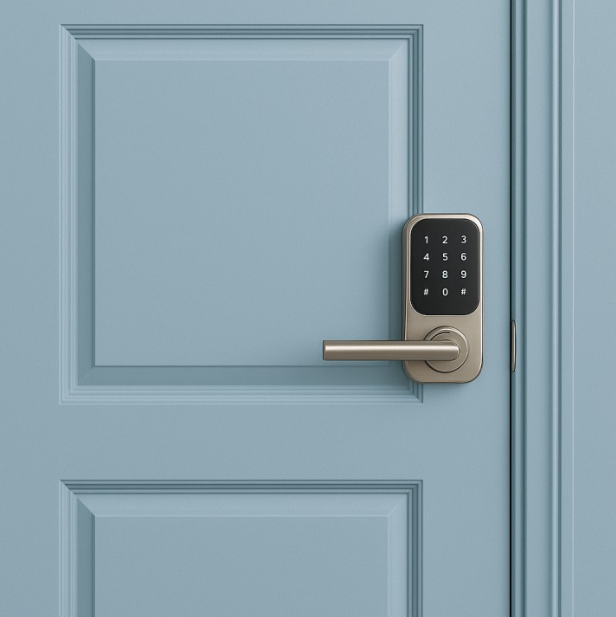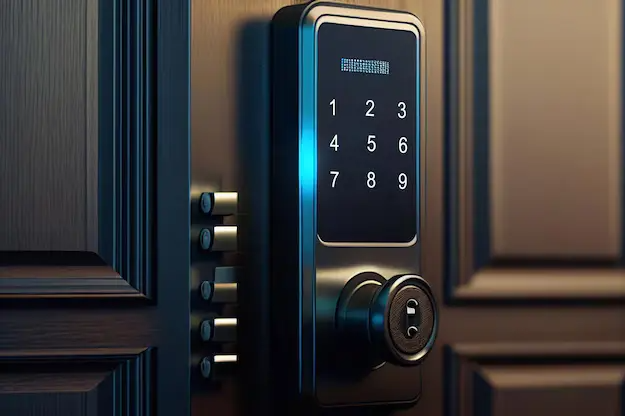In the rapidly advancing realm of home automation, latest smart lock technology is leading the charge toward a more secure and convenient future. As of September 2025, these devices have evolved far beyond simple keyless entry, incorporating cutting-edge features like ultra-wideband connectivity and biometric authentication to redefine how we protect our homes. Whether you’re a homeowner seeking effortless access or a renter looking for non-invasive solutions, understanding the latest smart lock technology can help you choose the right system for your needs. With seamless integration into smart home ecosystems, these locks offer remote monitoring, automated responses, and enhanced safety measures that were once the stuff of science fiction.
The surge in smart home adoption has propelled the latest smart lock technology into the mainstream, with market projections indicating continued growth driven by urban security concerns and IoT advancements. This year has seen remarkable innovations, from hands-free unlocking to AI-enhanced predictive security. In this comprehensive guide, we’ll explore the newest developments, installation tips, and maintenance advice to help you navigate this exciting field. For more insights, check out this smart lock guide to stay ahead of the curve.
Ultra-Wideband (UWB) and Hands-Free Unlocking: The Pinnacle of Latest Smart Lock Technology
One of the most groundbreaking aspects of latest smart lock technology in 2025 is the integration of ultra-wideband (UWB) for precise, hands-free unlocking. This technology uses centimeter-level accuracy to detect your smartphone or smartwatch as you approach the door, automatically disengaging the lock without any physical interaction. Models like the Schlage Sense Pro and Ultraloq Bolt Mission exemplify this trend, allowing seamless entry while preventing accidental unlocks from inside the home through spatial awareness features.
UWB represents a leap forward from traditional Bluetooth or NFC methods, offering faster and more reliable proximity detection. For families on the go, this means no more fumbling with keys or apps during rainy days or when hands are full. In terms of smart lock safety, UWB enhances security by verifying the user’s exact location, reducing the risk of unauthorized access. When considering how to pair smart lock devices with UWB, simply enable the feature in your phone’s settings and follow the app’s guided setup, which typically takes under five minutes.
Installation for UWB-enabled locks is user-friendly, often requiring only basic tools for smart lock installation. Ensure your door aligns with the lock’s specifications, and test the proximity range post-setup to optimize performance. As part of broader home security tips, pairing UWB locks with geofencing adds an extra layer, auto-locking when you leave the premises.
Advanced Biometrics: Facial, Palm, and Fingerprint Recognition in Latest Smart Lock Technology
Biometric authentication has reached new heights in latest smart lock technology, with facial recognition, palm vein scanning, and fingerprint readers becoming standard. Devices such as the Lockly Visage Zeno Series use facial detection to unlock doors simply by recognizing your face, even in varying lighting conditions. Similarly, palm print technology in models like the Philips EasyKey or TCL D1 Pro allows touchless entry by scanning unique vein patterns, offering higher accuracy than traditional fingerprints.
These features prioritize smart lock safety by using multi-factor verification, where biometrics combine with app-based codes for robust protection. For households with children or elderly members, this eliminates the need for memorized PINs, making daily access effortless. The accuracy of these systems has improved to over 99%, minimizing false positives and enhancing user trust. In commercial applications, such as offices or rentals, biometric locks enable quick access management, revoking permissions remotely without physical key exchanges.
For smart lock setup, biometric models often include self-calibration tools in their apps. During installation, register multiple users’ biometrics in a secure, encrypted database to ensure privacy. If issues arise, smart lock troubleshooting might involve cleaning sensors or updating firmware—simple steps that keep the system reliable. Incorporating these into your routine aligns with essential smart lock tips, like regular sensor checks for optimal performance.
The rise of multi-modal biometrics in latest smart lock technology also supports hybrid unlocking, blending fingerprints with voice commands via assistants like Alexa or Google Home. This versatility makes them ideal for diverse lifestyles, from busy professionals to tech enthusiasts.

Seamless Connectivity: Matter, Thread, and Wi-Fi in Latest Smart Lock Technology
Connectivity is a cornerstone of latest smart lock technology, with Matter-over-Thread emerging as the gold standard for interoperability. This protocol allows locks from different brands to work harmoniously with platforms like Apple HomeKit, Google Home, and Amazon Alexa, eliminating compatibility headaches. New releases, including the Yale Smart Lock with Matter and Nuki Smart Lock Ultra, feature built-in Thread for low-power, mesh networking that extends range and battery life up to 12 months.
Wi-Fi integration in models like the August Wi-Fi Smart Lock provides remote access without additional hubs, enabling real-time notifications for lock events. This is particularly useful for monitoring deliveries or granting guest access from afar. In 2025, enhanced encryption protocols protect against cyber threats, ensuring your connect smart lock remains secure. For how to pair smart lock with Matter devices, scan the QR code in the app and select your ecosystem—setup is streamlined for beginners.
Smart lock installation for connected models is straightforward, often retrofit-friendly for existing deadbolts. Post-installation, test integrations with other devices to confirm smooth operation. As connectivity evolves, so does smart lock battery life, with efficient chips reducing drain and including low-battery alerts via app push notifications.
Video-Integrated and AI-Powered Locks: Next-Level Innovations in Latest Smart Lock Technology
Video integration is transforming latest smart lock technology, merging door cameras with locking mechanisms for all-in-one security. The Lockly Vision Prestige, unveiled earlier this year, combines a high-resolution camera with two-way audio and motion detection, streaming live feeds to your phone. This setup not only controls access but also verifies visitors, enhancing overall safety.
AI enhancements take it further, analyzing patterns to predict and prevent issues. For instance, AI can detect unusual activity, like multiple failed access attempts, and trigger alerts or auto-lock. In family homes, these systems differentiate between residents and strangers, granting access accordingly. For smart lock troubleshooting, AI diagnostics in apps can identify connectivity glitches or sensor errors, guiding users through fixes.
Installation involves mounting the camera securely, followed by smart lock setup via Wi-Fi. Maintenance is minimal, but smart lock maintenance includes firmware updates for AI accuracy. These features align with the best smart lock guide principles, prioritizing intuitive tech for everyday use.
Portable and Retrofit Options in Latest Smart Lock Technology
For those avoiding permanent changes, portable smart lock and retrofit designs are booming in latest smart lock technology. These attach to existing hardware, offering keyless entry without drilling. The Ultraloq Latch 5 NFC is a prime example, supporting NFC taps and app control for renters or vacation properties.
Smart lock tips for portables include choosing models with strong adhesives for stability. Setup is tool-free, making them ideal for quick connect smart lock integrations.
Sustainability and Battery Innovations in Latest Smart Lock Technology
Sustainability is key in latest smart lock technology, with rechargeable batteries and eco-materials gaining traction. Models boast up to eight months of smart lock battery life on a single charge, thanks to lithium-polymer tech and solar-assisted options for outdoor use. This reduces waste and costs, appealing to environmentally conscious users.
For smart lock maintenance, monitor battery via apps and use USB-C ports for easy recharging. In cold weather, opt for temperature-resistant models to preserve performance. These advancements ensure long-term reliability without frequent interventions.
AI also optimizes power usage, dimming features when idle. As part of home security tips, sustainable locks contribute to greener homes while upholding security standards.

Addressing Challenges: Cybersecurity and Compatibility in Latest Smart Lock Technology
While latest smart lock technology offers immense benefits, cybersecurity remains a concern. End-to-end encryption and two-factor authentication are now standard, protecting against hacks. Regular updates patch vulnerabilities, and offline modes provide fallback access.
Compatibility issues are mitigated by Matter, but for older systems, bridges may be needed. Smart lock troubleshooting for connectivity involves resetting networks or checking signal strength. Costs range from $150 for basics to $500 for advanced models, but savings from reduced key losses offset expenses.
Professional smart lock installation is advisable for complex setups, ensuring proper alignment and wiring. Following smart lock tips like using strong passwords enhances safety.
Selecting the Best from Latest Smart Lock Technology
Choosing from latest smart lock technology depends on your needs: UWB for hands-free, biometrics for security, or portables for flexibility. Consult the best smart lock guide for comparisons, focusing on Matter support and battery ratings. Test apps for ease and prioritize ANSI-certified durability.
For families, multi-user biometrics shine; for rentals, portable smart lock options excel. Ensure smart lock setup includes all household members for seamless use.
Conclusion: Embrace Latest Smart Lock Technology for Enhanced Security
The latest smart lock technology in 2025 is revolutionizing home security with innovative features that blend convenience, intelligence, and sustainability. From UWB hands-free entry to AI-driven protections, these devices offer unparalleled peace of mind. By following smart lock tips for installation, maintenance, and troubleshooting, you can fully leverage their potential. Upgrade today with guidance from trusted smart lock resources—secure your future with the power of modern tech.